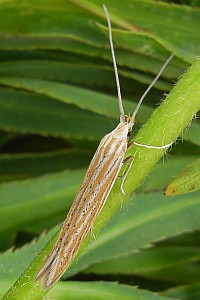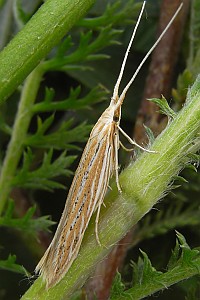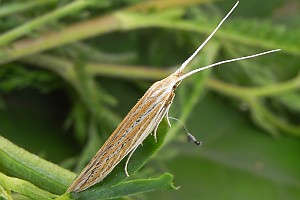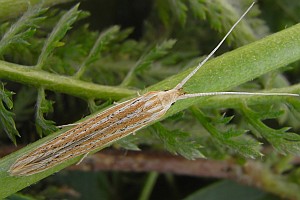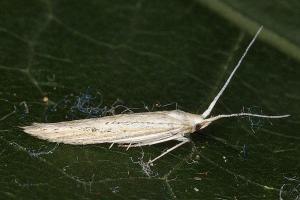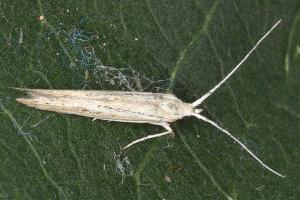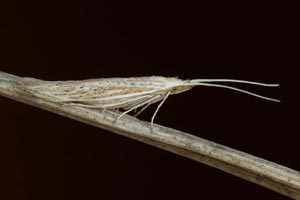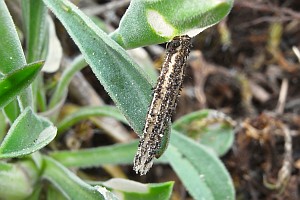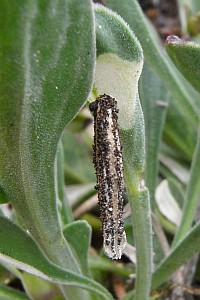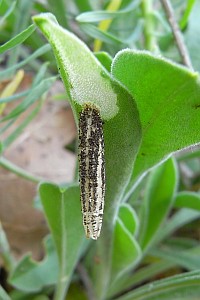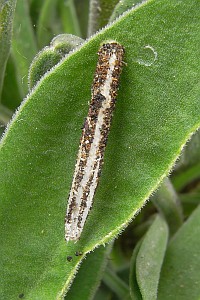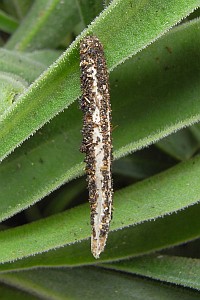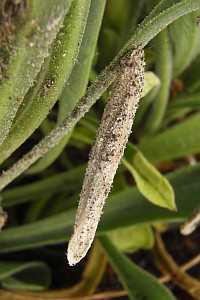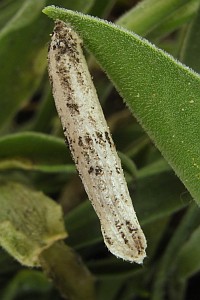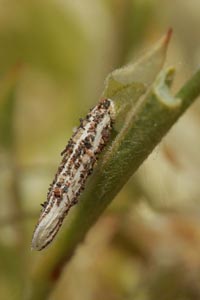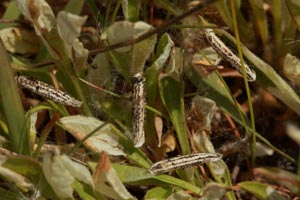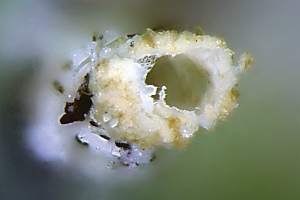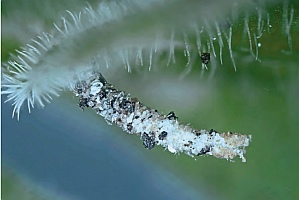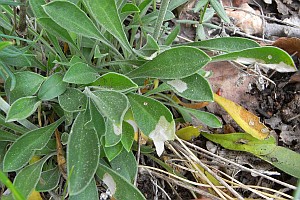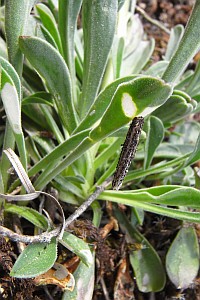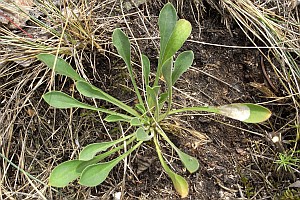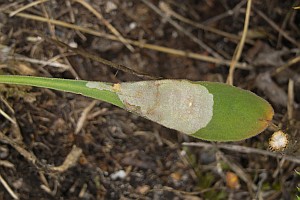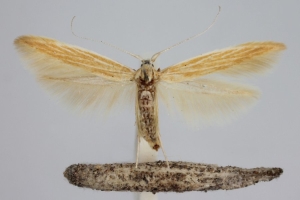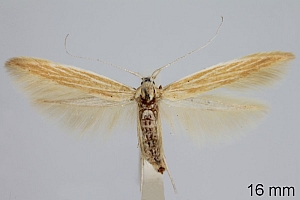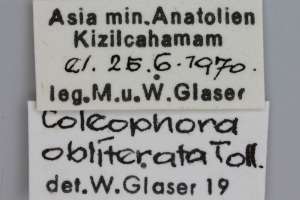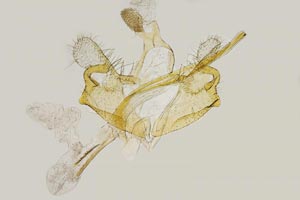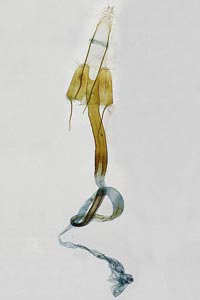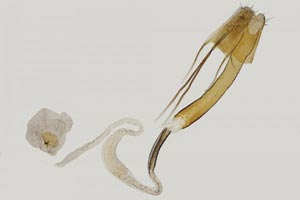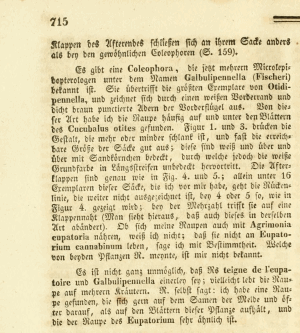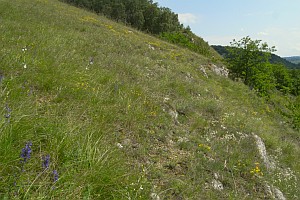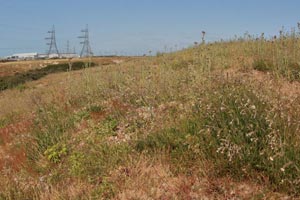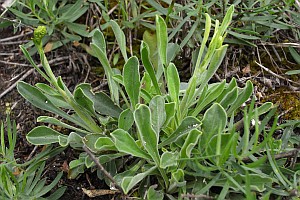

 +27Kontinente:EUAS
+27Kontinente:EUAS
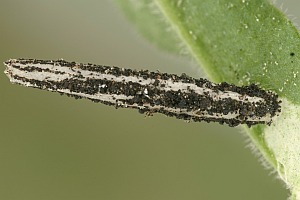

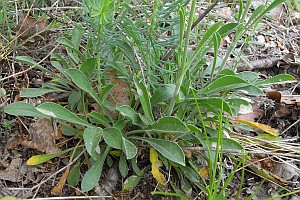


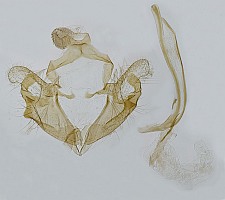

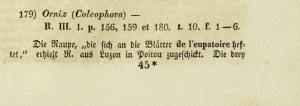
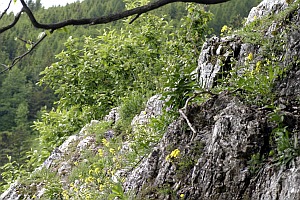
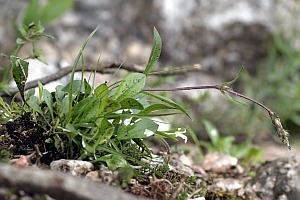
1. Lebendfotos
1.1. Falter
1.2. Raupe, Raupensack (nach der Überwinterung)
1.3. Jungraupe (vor der Überwinterung)
1.4. Fraßspuren und Befallsbild
2. Diagnose
2.1. Weibchen
2.2. Geschlecht nicht bestimmt
2.3. Genitalien
2.3.1. Männchen
2.3.2. Weibchen
2.4. Raupensack
Die aus ausgeschnittenen Blättern gebauten Säcke wären ebenso weißlich wie die Minen, wären sie nicht in charakteristischer Weise mit kleinen Sand- und Humusteilchen belegt, die auffällige Längsstreifen bilden. Ähnliche Säcke an Leimkraut (Silene sp.) bauen lt. Hering 1954 noch Coleophora nubivagella (Falter ohne die eingestreuten schwarzen Schuppen in den weißen Elementen der Vorderflügel) und Coleophora ciconiella (Minen nur im Herbst, selten). (Peter Buchner)
2.5. Erstbeschreibung
3. Biologie
3.1. Habitat
3.2. Raupennahrungspflanzen
3.3. Nahrung der Raupe
- [Caryophyllaceae:] Silene nutans [= Cucubalus nutans] (Nickendes Leimkraut)
- [Caryophyllaceae:] Silene otites [= Cucubalus otites] (Ohrlöffel-Leimkraut)
- [Caryophyllaceae:] Silene italica [= Cucubalus italicus] (Italienisches Leimkraut)
- [Caryophyllaceae:] Silene vulgaris [= Silene inflata] (Aufgeblasenes Leimkraut, Taubenkropf-Leimkraut, Gewöhnlicher Taubenkropf, Gewöhnliches Leimkraut)
- [Caryophyllaceae:] Silene viscaria [= Lychnis viscaria, Viscaria vulgaris, Viscaria viscosa] (Gewöhnliche Pechnelke)
- [Caryophyllaceae:] Arenaria grandiflora ? (Großblütiges Sandkraut ?)
- [Caryophyllaceae:] Cerastium arvense ? (Acker-Hornkraut ?)
Wie die obigen Bilder zeigen, wurde die Art in Deutschland und Österreich an Silene nutans und Silene otites gefunden. Nach Heckford & Beavan (2022) ist die Art in Großbritannien ganz an Silene nutans gebunden. Baldizzone (2019: 462) listet weitere verwandte Nelkengewächse: "Piante alimentari: Silene die varie specie (italica, otites, nutans, vulgaris), Lychnis viscaria (Caryophyllaceae)." Der Autor fährt fort: "Segnalata da Nel (2001) anche su Arenaria grandiflora e Cerastium arvense (Caryophyllaceae)." Ob es sich bei den beiden Letzteren um Freiland-Nahrungspflanzen handelt, weiß ich noch nicht, da mir die Arbeit noch nicht vorliegt.
(Autor: Erwin Rennwald)
4. Weitere Informationen
4.1. Andere Kombinationen
- Casignetella galbulipennella (Zeller, 1838) [so bei Anikin et al. (2017) und Sinev (2019)]
4.2. Synonyme
- Coleophora otitae Zeller, 1839 [synonymisiert von Baldizzone (1994: 192)]
- Coleophora obliterata Toll, 1952
4.3. Typenmaterial
Baldizzone (1994: 192) designierte einen Lectotypus: “Lectotypus ♂ [designato in questa sede]: in buone condizioni conservato presso il BMNH, recante le seguenti etichette: 1) “LECTOTYPE” (rotondo, orlato di rosso, a stampa), 2) “Zeller Coll. Walsingham Collection 1910-427” (a stampa), 3) “B.M. ♂ Genitalia slide No.26007” (a stampa e mano).”
4.4. Literatur
- Anikin, V.V., Sachkov, S.A. & V.V. Zolotuhin (2017): "Fauna lepidopterologica Volgo-Uralensis": from P. Pallas to present days. — Proceedings of the Museum Witt Munich, Volume 7: 1-696; Munich and Vilnius.
- Lectotypus-Festlegung: Baldizzone, G. (1994): Contribuzioni alla conoscenza dei Coleophoridae LXXV. Coleophoridae dell'Area Irano-Anatolica e regioni limitrofe (Lepidoptera). — Associazione Naturalistica Piemontese Memorie 3: 1-423. Stenstrup (Apollo Books).
- Baldizzone, G. (2019): Fauna d’Italia. Vol. LIII. Lepidoptera Coleophoridae. - XVII + 907 S.; Milano (Calderini).
- Будашкин, Ю. И. & А. В. Жаков (2013): Чехликовые моли (Lepidoptera, Coleophoridae): к фауне степной зоны Украины. Сообщение 3 [Budashkin, Yu. I. & A. V. Zhakov (2013): Case-Bearer Moths (Lepidoptera, Coleophoridae): Contribution to the Ukrainian Steppe Zone Fauna. Third Report]. — Українська ентомофауністика 4 (1): 33–42.
- Будашкин, Ю. И., Рихтер, И. & Ю. Табель (2015): Новые находки молей-чехлоносок (Lepidoptera: Coleophoridae) в России и в Армении. — Эверсманния 41: 11–22.
- Heckford, R. J. & S. D. Beavan (2022): Coleophora galbulipennella Zeller, 1838 (Lepidoptera: Coleophoridae): observations on the larval stage in September 2021 found at Dover, Kent, England. — Entomologist’s Gazette 73: 33–38.
- Nel, J. (2001): Atlas des genitalia mâles et femelles des lépidoptères Coleophoridae de France. — Revue de l'Association Roussillonnaise d'Entomologie, Supplement 10: 1-34. [Sekundärzitat]
- Richter, I. (2017): New findings of the case-bearing moth genus Coleophora from the Balkan Peninsula with the description of Coleophora vardarella sp. nov. (Lepidoptera: Coleophoridae). — Microlepidoptera.hu 12: 83-94. [PDF auf oszk.hu] bzw. [ganzes Heft: PDF auf oszk.hu]
- SCHÜTZE (1931): 89
- Синёв, С. Ю. [ed.] (2019): Каталог чешуекрылых (Lepidoptera) России. Издание второе [Sinev, S. Yu. (ed.) (2019): Catalogue of the Lepidoptera of Russia. Second edition]: 1-448.
- Stainton, H. T. (1859): The natural history of the Tineina 4: I-IX, 1-292, pl. I-VIII. London (John van Voorst) – Paris (Deyrolle) – Berlin (E. S. Mittler und Sohn). — Digitalisat auf archive.org: [142-149], [pl. III fig. 3] (unter dem Namen Coleophora otitae).
- Beschreibung als Coleophora obliterata: Toll, S. (1952): Etude sur les génitalia de quelques Coleophoridae X. — Bulletin de la Société Entomologique de Mulhouse 8: 17-24, 27-30, 35-39, 43-47, 53-56, 61-65.
- Erstbeschreibung: Zeller, P. C. (1838): Kritische Bestimmung der in Reaumur's Mémoires pour servir à l'histoire des insectes vorkommenden Lepidopteren. — Isis von Oken 1838 (9-10): 625-736.


























